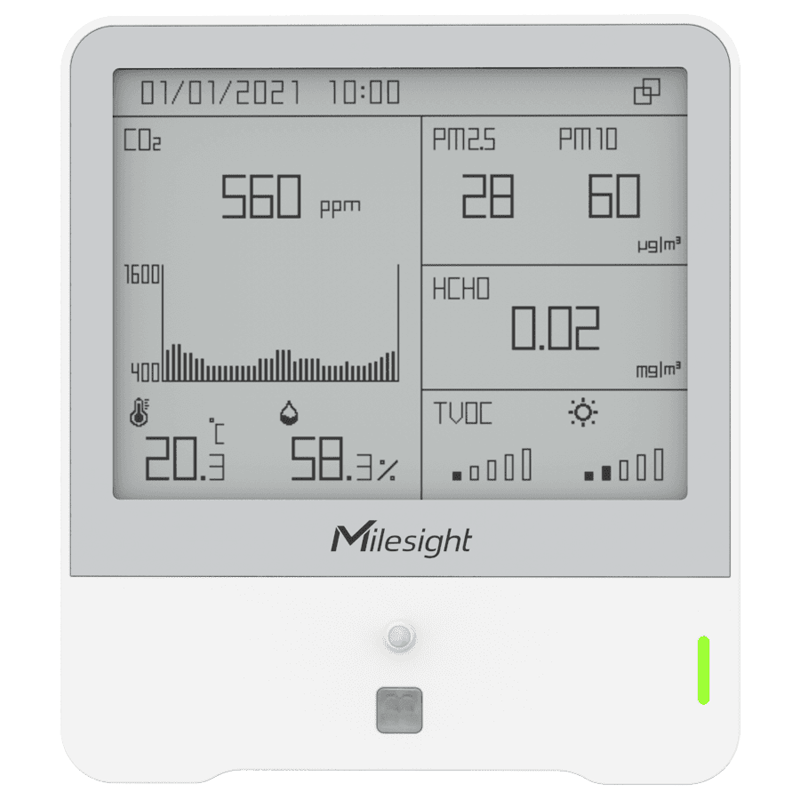Last updated on June 5th, 2025 at 08:53 pm
In the realm of facilities management, ensuring optimal indoor air quality (IAQ) is paramount for creating healthy and productive environments. With the advent of IoT (Internet of Things) technology, indoor air quality sensors have emerged as powerful tools for monitoring and maintaining IAQ levels. In this article, we explore the best indoor air quality sensors for facilities management, their features, and how they contribute to smart facilities management outcomes.
Choosing the Best Indoor Air Quality Sensors:

1. Ambience Monitoring Sensor: The Ambience Monitoring Sensor is a versatile IAQ sensor designed to monitor various parameters, including temperature, humidity, CO2 levels, and volatile organic compounds (VOCs). This comprehensive sensor provides real-time data on indoor environmental conditions, enabling facility managers to identify potential air quality issues and take corrective actions promptly.
2. 7-in-1 IAQ Sensor: The 7-in-1 IAQ Sensor is a multifunctional sensor that measures seven key IAQ parameters: temperature, humidity, CO2 levels, VOCs, particulate matter (PM2.5 and PM10), and formaldehyde (HCHO). With its advanced sensor technology and high accuracy, this sensor provides comprehensive insights into indoor air quality, allowing facility managers to proactively manage IAQ and create healthier indoor environments.

3. 9-in-1 IAQ Sensor: The 9-in-1 IAQ Sensor is an advanced IAQ sensor that measures nine essential parameters: temperature, humidity, CO2 levels, VOCs, PM2.5, PM10, formaldehyde, nitrogen dioxide (NO2), and ozone (O3). This sensor offers unparalleled accuracy and precision, making it ideal for applications where precise IAQ monitoring is essential, such as healthcare facilities, laboratories, and cleanrooms.
Benefits of Using Indoor Air Quality Sensors:
1. Early Detection of Air Quality Issues: Indoor air quality sensors provide real-time data on IAQ parameters, allowing facility managers to detect air quality issues, such as high CO2 levels, elevated VOC concentrations, or particulate matter pollution, before they escalate. Early detection enables prompt corrective actions, preventing potential health risks and ensuring a safe indoor environment for building occupants.
2. Optimization of Ventilation Systems: By continuously monitoring IAQ parameters, indoor air quality sensors help facility managers optimize ventilation systems to maintain optimal air quality levels. Sensors can detect fluctuations in temperature, humidity, and pollutant levels, allowing for automatic adjustments to airflow rates and ventilation settings to ensure a comfortable and healthy indoor environment.
3. Compliance with Regulations and Standards: Indoor air quality sensors play a crucial role in helping facilities comply with regulations and standards governing indoor air quality. By monitoring IAQ parameters and providing data on air quality levels, sensors enable facility managers to demonstrate compliance with regulatory requirements and ensure the health and safety of building occupants.
Integration with FacilityBot CMMS: FacilityBot’s CMMS solution seamlessly integrates with IoT sensors, including indoor air quality sensors such as the Ambience Monitoring Sensor, 7-in-1 IAQ Sensor, and 9-in-1 IAQ Sensor, available at FacilityBot IoT Sensor store. This integration empowers facility managers to:
- Monitor IAQ in Real-Time: Utilize real-time data from indoor air quality sensors to monitor IAQ parameters and identify potential air quality issues.
- Automate Maintenance Tasks: Implement automated maintenance tasks based on IAQ sensor data, such as scheduling HVAC system inspections, filter replacements, and ventilation system cleaning.
- Optimize Facility Operations: Leverage IAQ sensor data to optimize facility operations, including energy management, occupant comfort, and regulatory compliance, leading to improved overall facility performance.
Conclusion: In conclusion, choosing the best indoor air quality sensors is essential for facilities management, enabling proactive monitoring and management of indoor environmental conditions. By integrating indoor air quality sensors with FacilityBot’s CMMS solution, facility managers can harness the power of IoT technology to achieve smart facilities management outcomes, including improved IAQ, enhanced occupant health and comfort, and regulatory compliance. Visit FacilityBot to learn more about our CMMS solution and IoT integration capabilities.



